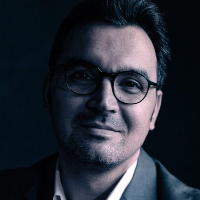The Analytical Study of Grotesque in the Works of Painters of the Islamic Revolution With Concentration on the Works of Habibollah Sadeghi, Kazem Chalipa and Hossein Khosrojardi
Grotesque has long been known as a protest and conceptual method, and artists have used grotesque to reveal the hidden truths of the lesser-known truths. Convulsion, revolution and war in Iran in the 1970s and 1980s made a historic fate for this country. The painting of the Revolution was the result of a political movement, which was formed under the name of the justice movement by a group of young artists to accompany the revolution. When the ruling regime in Iran acted brutally to kill its opponents in an attempt to survive, the grotesque spirit was fully visible in the community and this was not overlooked by the argus-eyed painters of the Islamic Revolution who created works that were consciously in line with the liberal movement of that time. Thus, the painters of the revolution, using grotesque, exhibited the characteristics of the society in those days. After the victory of the Revolution, and after the onset of the imposed war, artists continued their companionship with the issues and problems of the day and its evolutions by creating works. The aim of this research is to know more about the art of the Revolution and to analyze the function of grotesque in the works of the painters of the Islamic Revolution. Accordingly, this research seeks to answer these questions: 1. How did grotesque emerge in the works of the Revolution’s painters? 2. What are the functions of grotesque in the works of the Revolution’s painters? Which categories of grotesque do the works by the Islamic Revolution’s artists include? Using a descriptive-analytical approach, library resources and observation of works, this comparative study examines the model of the four thinkers on grotesque and its categorization in visual arts, the most important areas of creating and producing concepts of works in the process of utilizing grotesque and the generative process of meaning are examined as well. Also, elements relations analysis and structure analysis of works have been done according to Charles Jensen's model in Visual Arts works analysis book. The statistical population of the study includes the works of Iranian Revolutionary Painters. Nine important works of the early core members of the revolutionary painters, Mr. Habibollah Sadeghi, Kazem Chalipa and Hossein Khosrojerdi, are considered as a statistical sample using judgmental sampling method.
In this research, grotesque was first studied in terms of etymology and its meanings and concepts were mentioned in culture and art. Then, grotesque is categorized and its types are specified. Since this topic has always been the concern of many theorists and scholars, the next section of this paper is devoted to the theories provided by the thinkers of this field. In the final section of the study, grotesque has been identified and its outbreak and its functions in the revolutionary painters' works have been addressed. Finally, the classification of grotesque works is presented in the form of a table, in terms of types, important elements of content and the main elements of grotesque. The result of the study shows that the Revolution’s painters used grotesque not as a style, but as an attitude and worldview to express their goals, and most of the works of the statistical population of this study is in the category of pure grotesque. They have strongly used grotesque and their purpose from drawing ugliness, septicity and inelegances is showing the departure of man from his divine principle and reminding this matter. In all the works of these artists, there is a kind of binary opposition between good and evil, goodness and badness, beauty and ugliness, and right and wrong. Using grotesque, these artists exhibited weaknesses, shortcomings and inconsistencies, and tried to make the audience aware of the rogues and villainies of the community. In fact, grotesque is a determinative factor in their works and acts as a tool to encounter us with the truth. In effect, the approach of Revolution’s painters to grotesque is a cynical approach, full of anxiety and fear. Revolution’s painters benefit from grotesque for political, social and moral reform. Their main focus is on human and his body; the bodies that have lost their spirituality and are fitted with grotesque characteristics. The painters of the Revolution depict grotesque not as a style and method, but as an attitude combined with humor and gravity, fear and hope, fear and conflict, laughter and fear, exorbitance and exaggerations, nihility and devastation in their works.
- حق عضویت دریافتی صرف حمایت از نشریات عضو و نگهداری، تکمیل و توسعه مگیران میشود.
- پرداخت حق اشتراک و دانلود مقالات اجازه بازنشر آن در سایر رسانههای چاپی و دیجیتال را به کاربر نمیدهد.



